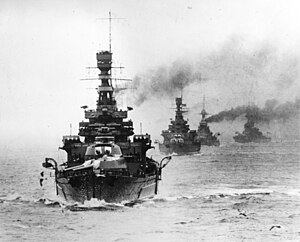Atlantic Fleet (United Kingdom)
| Atlantic Fleet | |
|---|---|
 Battlecruisers of the Atlantic Fleet | |
| Active | 1909-1914;1919-1932 |
| Country | |
| Branch | |
| Type | Fleet |
The Atlantic Fleet was a major fleet formation of the Royal Navy. There have been two main formations in the Royal Navy officially called the Atlantic Fleet. The first was created in 1904 and lasted until 1914. The second lasted from 1919 until 1932.
History
On 14 December 1904 the Channel Fleet was re-styled the 'Atlantic Fleet'.[1] The Atlantic Fleet lasted until 1912 when rising tensions with Germany forced the Royal Navy to relook at fleet formations and the Atlantic Fleet became the 3rd Battle Squadron.[2]
The Atlantic Fleet was again formed after the end of World War I, when British naval forces were reorganised to reflect the changed economic and political situation in Europe. The fleet was created upon the disbandment of the Grand Fleet in April 1919, absorbing many, but not all of its elements. It was placed under a Commander-in-Chief, who for part of that year held the title of Commander-in-Chief Atlantic and Home Fleets, before the Home Fleet became the Reserve Fleet and a totally separate command. HMS Queen Elizabeth became the Fleet's flagship and served in that capacity until 1924.[3]
The fleet never fought in a naval battle in its short history. The fleet's only point of note in history was in 1931, during the Invergordon Mutiny. Sailors of the fleet openly refused to obey orders over a dispute on pay sparked by the government at the time.[4] The fleet's short history ended in 1932, when the Admiralty having been shaken by the events of the Invergordon Mutiny, renamed the fleet, as the Home Fleet.[5]
Commander-in-Chiefs First Formation
Commanders have included:[6]
- Vice-Admiral Lord Charles Beresford (December 1904-March 1905)
- Vice-Admiral Sir William May (1905–1907)
- Vice-Admiral Sir Assheton Curzon-Howe (1907–1908)
- Vice-Admiral Prince Louis of Battenberg (1908–1910)
- Vice-Admiral Sir John Jellicoe (1910–1911)
- Vice-Admiral Sir Cecil Burney (1911–1912)
Commander-in-Chiefs Second Formation
Commanders have included:[7]
- Admiral Sir Charles Madden (1919–1922)
- Admiral Sir John de Robeck (1922–1924)
- Admiral Sir Henry Oliver (1924–1927)
- Admiral Sir Hubert Brand (1927–1929)
- Admiral Sir Ernle Chatfield (1929–1930)
- Vice Admiral Sir Michael Hodges (1930–1931)
- Admiral Sir John Kelly (1931–1932)
References
- ^ National Archives records
- ^ "Navy Estimates 1912-13". Hansard. Retrieved 2 September 2012.
- ^ "HMS Queen Elizabeth". Retrieved 2 September 2012.
- ^ "The Invergordon Mutiny". Retrieved 2 September 2012.
- ^ "Home Fleet listing for 1933". Archived from the original on October 26, 2009. Retrieved 2 September 2012.
{{cite web}}: Unknown parameter|deadurl=ignored (|url-status=suggested) (help) - ^ Senior Royal Navy Appointments Archived March 15, 2012, at the Wayback Machine
- ^ Whitaker's Almanacks 1919–1932
- Fleet Organisation Accessed March 2010
